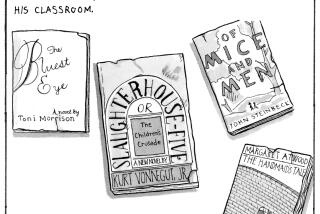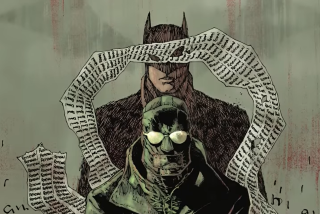Exclusive ‘Fight Club 2’ pages: Tyler Durden’s been around for longer than we thought
Let’s talk about “Fight Club.”
Specifically, “Fight Club 2,” the comic book sequel of the novel that introduced readers to the nameless narrator and the charismatic Tyler Durden, and was adapted into the cult favorite film directed by David Fincher.
Author Chuck Palahniuk had never considered the comic book format for the sequel until a dinner set up by a friend in Oregon.
“Portland is just filled with important comic people,” explained Palahniuk. “A friend of mine threw a dinner party and kind of set me up on this blind date with Brian Bendis and Matt Fraction and Kelly Sue [DeConnick], and they all spent the dinner telling me I have to do this graphic novel, and offering to help me with it.”
Palahniuk had just finished a short story collection, and with these teachers he realized it was the perfect time to learn a new storytelling skill.
“The movie had such a following and the book had such a following that I didn’t want to follow up with a sequel in either of those forms,” said Palahniuk. “Something like a graphic novel seemed like a good way for a sequel to establish its own authority through a different medium.”
Palahniuk spoke with Hero Complex over the phone to discuss Sebastian, Tyler, Marla and “Fight Club 2.”
Hero Complex readers also get an exclusive first look at the first 8 pages of “Fight Club 2” No. 2. included in the gallery above.
How different is it for you creatively working in the comic book format?
It’s not as chompy as the novel was. The novel was written sort of a sentence a day, sometimes a paragraph a day while I was working full time.
The comic format calls for ideally a reveal with every page turn, because the only place you can really surprise someone is with the image on the upper left hand page. So you want to have the set up in the lower right hand page and when they turn that page you want to have a payoff.
That was just a new formatting requirement that I had to learn.
I had to learn more graceful visual transitions because in books, especially in “Fight Club,” I can use a reoccurring chorus as my transition and cut scenes without really verbose transitions. The rules of “Fight Club” allowed me to cut those scenes like they were film.
In a comic I needed to develop more of a lyrical, graceful, visual way or moving between scenes.
How is it working with a whole creative team?
It was fantastic. Because usually, I’ve reached the point as the author that everybody looks to me to tell them what to do and to produce the entire thing and then to go out and be the lead in promoting.
It was so nice to be the student for a change - to be able to relax and be taught and coached by other people. Especially younger people who knew the storytelling medium so much better.
When reading the comic, the meta-fictional elements like pills and flower petals that sit on top of the panels makes it clear that you’re reading pages in a comic book. What motivated you to include these elements?
With a book I really like to include nonfiction elements like rules in the course of the book, and the nonfiction elements add a kind of reality to the fiction.
In the movie David Fincher was so great at acknowledging a fact that you’re watching a film by messing with the medium of film by acknowledging the splices and the changeovers and then allowing the film to burn ... things like that and breaking the fourth wall with the actors speaking directly to the audience.
With the graphic novel we wanted to do some kind of fancy meta things like that. Obscuring the faces and obscuring the dialogue to kind of lessen their power so it wasn’t all about words or all about people.
Also the incomplete thing is so much more compelling than that thing that is so readily apparent and so readily consumed.
I tend to be dialogue-heavy compared to comics. So I really had to pare my dialogue back and make the dialogue not so precious.
Does the fact that “Fight Club” has a following affect the way you approach the sequel? Are you conscious of that audience?
Initially I wasn’t and I just wrote the 10 issues. Then I went to a comic con in seattle, the Emerald City Comicon, and during a panel with this big audience, people kept on standing up and asking if “so-and-so” was coming back, and I realized that people didn’t want something that was entirely new and novel. They wanted a big percentage of revisiting things that they had seen in the previous narratives and really, really liked.
So I’ve been rewriting like crazy bringing back these secondary characters and giving them plotlines of their own.
For this comic series, the narrator is Tyler. Why this change?
I just like doing the opposite. Having Tyler make the pithy comments and Tyler talking about the unexamined life because Tyler is the fully expressed character and Sebastian (the narrator of the original novel) is the fully suppressed character.
Who wants to hear the narration from the fully suppressed character who has no self-awareness?
How much have Tyler and Sebastian changed for you in the intervening years since the book?
On one level they’ve expanded because I realized that the original book was kind of about a single psychotic episode in one man’s life and I wanted to expand that so it wasn’t just a single occurrence. It was something that had happened again and again across time and would continue to happen moving into the future to subsequent descendents of this person so I could build a kind of Lovecraft mythology that was expanding in both directions from what we thought of as just a single occurrence. That was the biggest change.
When we first really see Tyler in the first issue, he makes a phone call to tell someone he’s back. Was that you?
That’s me! We get to do this meta thing later where Marla is looking for different iterations of Fight Club and she ends up stumbling into our workshop. We have this kind of Perseus addressing the gods, beseeching the gods for their guidance and their assistance scene that allows me to promote the images and the names of my fellow writers.
With Sebastian being an actual biological father in “Fight Club 2,” and Tyler sort of in the role as Project Mayhem’s father, what aspects of fatherhood are you trying to explore in the series?
One thing I kind of launch into in the third issue is an idea that Joseph Campbell wrote about that not just young men but also young women need not just a biological father but a secondary father figure. They tend to be a kind of minister or a teacher or a military officer or a sports coach.
At this point in history so many of those secondary fathers have become kind of pariahs and are just disappearing because of sexual scandals or other reasons and now some young men and young women are losing out on that secondary father which is needed to bring them into adulthood.
What I loved most about Campbell is that he said this is why street gangs are so popular. Because they serve the function of that secondary father. They discipline the child and they send the child out on quests and assignments, challenges that will build the child’s ability and confidence and they reward the child for completing these things.
So I really wanted to bring all of that Joseph Campbell stuff into the forefront and demonstrate that as part of the series.
Marla takes up with children in a progeria support group. Why did you chose kids with progeria?
Progeria seems like such a good metaphor, especially for Marla, someone who finds herself kind of prematurely matured into a kind of a static rut that she doesn’t have to be in.
They’ve kind of conformed to an idea of adulthood that’s been given to them by the culture and they find themselves sort of play-acting that they’re adults prematurely. I thought progeria expressed that premature aging, that calcification better than anything.
I also thought they would be unlikely heroes. They’ve really become the heroes of the book. All those kids and also there’s the one child who’s closest to Marla. There’s a big reveal about her, and you’ll be shocked to find out who she actually is.
Do we find out more about Marla in the series? Or do we stick closer to Sebastian and Tyler?
We stick close to Sebastian and Tyler just because I don’t want to do too much, but Marla plays at least an equal part in the ongoing narrative.
She’s not just the girlfriend anymore, she’s actively on a quest but with her own team of people.
Were you conscious about giving Marla a more significant story line?
I was. I wanted her to be a fully fledged character who would be cause in the matter.
In the novel she is the catalyst. She is the thing that makes change necessary. If [the narrator] wants to have any kind of intimate relationship with another person, he’s going to have to change.
But in this book I really wanted her to be the cause in disrupting this completely inauthentic life that they’ve set up.
Do we revisit Sebastian’s unawareness of Tyler in his medicated state?
We don’t so much revisit that as we revisit his unawareness of Tyler’s dealing in his life as a child. That his entire life has been shaped by Tyler, not just the recent 10 years.
Do we see bits of Tyler in Junior?
There’s much more of that toward the end but I don’t want to give too much away.
Starting in Issue 2 we see Sebastian heading back into the world of Fight Club and Project Mayhem. How much has that world changed since Sebastian left it?
It’s changed in that Project Mayhem has become institutionalized as this kind of Blackwater or Halliburton global corporation that provides military services and is basically fighting on every side of every conflict.
But the thing that’s really changed is that Sebastian himself is no longer the young man that he was 10 years before and he has to come to terms with that in a couple big scenes.
Is Sebastian ready for the physicality of Fight Club?
I don’t want to give it away but he’s not. He gets his [butt] kicked through this entire book until the very end.
It’s funny because Cameron Stewart, the illustrator, we were meeting and he was asking if Sebastian can heal really quickly because he’s always being brutalized so much and it’s really hard to express emotion on his face when his face is so beat up.
So we decided that Sebastian would really heal very quickly from one fight to the next from one attack to the next.
Twitter: @tracycbrown
More to Read
The biggest entertainment stories
Get our big stories about Hollywood, film, television, music, arts, culture and more right in your inbox as soon as they publish.
You may occasionally receive promotional content from the Los Angeles Times.







